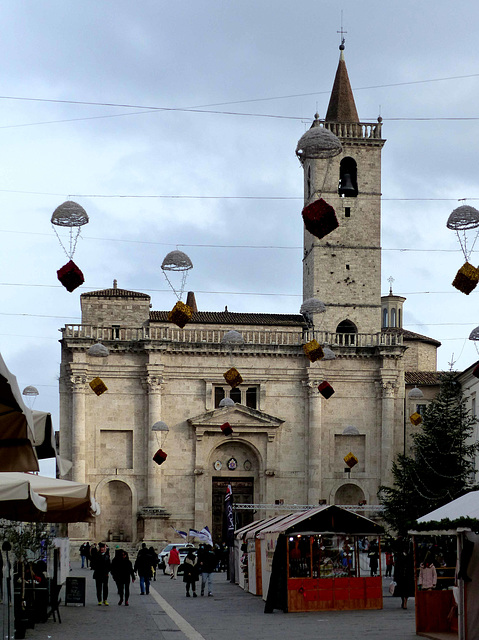Location
Lat, Lng:
Lat, Lng:
You can copy the above to your favourite mapping app.
Address: unknown
Lat, Lng:
You can copy the above to your favourite mapping app.
Address: unknown
Keywords
Authorizations, license
-
Visible by: Everyone -
All rights reserved
-
43 visits
Ascoli Piceno - Cattedrale di Sant'Emidio


In 268 BC Ascoli became a Roman "civitas foederata" but after it had revolted against Rome, it was reconquered and destroyed by Pompeius Strabo in 89BC.
During the Middle Ages Ascoli was ravaged by the Ostrogoths and then by the Lombards. After nearly two centuries as part of the Lombard Duchy of Spoleto (593–789), Ascoli was ruled by the Franks but ultimately it was the bishops that gained influence and power over the city.
In 1189 a free republican municipality was established but it experienced the sacking and destruction by the imperial armies of Frederick II. Municipal freedoms got undermined by factional struggles between the most prominent families. The internal unrest between opposing factions did not cease, leading to decades of rebellions, massacres, raids, the growth of banditry, and the decline of civil virtues. This unstable situation opened the way to foreign dictatorships, such as condottiero (mercenary) Galeotto Malatesta (14th century) who is driven out by a revolt, and later on, Francesco Sforza who established a cruel dictatorship (15th century) which was overthrown in 1482, even if Ascoli was forced to recognize the sovereignty of the Church.
The town was called "Ascoli" until 1862, when "Piceno" was added, evoking the Picenes, which lived between the 8th and 6th centuries BC. here.
The current cathedral is the result of numerous reconstructions that took place between the 5th and 16th centuries. Some remains show that the first temple was built on a pre-existing Roman building as early as the 4th or 5th century.
Archaeological findings prove that the cathedral was built on the remains of the Roman forum. Between the 5th and 6th centuries, the building underwent its first transformation, which gave the complex the shape of a Latin cross. Between 746 and 780, the Lombard bishop Euclere added the dome with an octagonal plan. This was completed in the 11th century, when the Romanesque structure was finished with the construction of the façade and, above all, the construction of the crypt to keep the relics of Saint Emidio. At the same time, the construction of the two towers began.
The building kept its Romanesque forms until the last quarter of the fifteenth century. In 1481 the contract for the demolition of the old facade was signed. The current façade was built between 1529 and 1539 according to a design by Nicola Filotesio (alias "Cola dell'Amatrice").
The Christmas market is held in the square in front of the Duomo. Some gifts are still hanging from the parachutes.
During the Middle Ages Ascoli was ravaged by the Ostrogoths and then by the Lombards. After nearly two centuries as part of the Lombard Duchy of Spoleto (593–789), Ascoli was ruled by the Franks but ultimately it was the bishops that gained influence and power over the city.
In 1189 a free republican municipality was established but it experienced the sacking and destruction by the imperial armies of Frederick II. Municipal freedoms got undermined by factional struggles between the most prominent families. The internal unrest between opposing factions did not cease, leading to decades of rebellions, massacres, raids, the growth of banditry, and the decline of civil virtues. This unstable situation opened the way to foreign dictatorships, such as condottiero (mercenary) Galeotto Malatesta (14th century) who is driven out by a revolt, and later on, Francesco Sforza who established a cruel dictatorship (15th century) which was overthrown in 1482, even if Ascoli was forced to recognize the sovereignty of the Church.
The town was called "Ascoli" until 1862, when "Piceno" was added, evoking the Picenes, which lived between the 8th and 6th centuries BC. here.
The current cathedral is the result of numerous reconstructions that took place between the 5th and 16th centuries. Some remains show that the first temple was built on a pre-existing Roman building as early as the 4th or 5th century.
Archaeological findings prove that the cathedral was built on the remains of the Roman forum. Between the 5th and 6th centuries, the building underwent its first transformation, which gave the complex the shape of a Latin cross. Between 746 and 780, the Lombard bishop Euclere added the dome with an octagonal plan. This was completed in the 11th century, when the Romanesque structure was finished with the construction of the façade and, above all, the construction of the crypt to keep the relics of Saint Emidio. At the same time, the construction of the two towers began.
The building kept its Romanesque forms until the last quarter of the fifteenth century. In 1481 the contract for the demolition of the old facade was signed. The current façade was built between 1529 and 1539 according to a design by Nicola Filotesio (alias "Cola dell'Amatrice").
The Christmas market is held in the square in front of the Duomo. Some gifts are still hanging from the parachutes.
Annemarie has particularly liked this photo
- Keyboard shortcuts:
Jump to top
RSS feed- Latest comments - Subscribe to the comment feeds of this photo
- ipernity © 2007-2024
- Help & Contact
|
Club news
|
About ipernity
|
History |
ipernity Club & Prices |
Guide of good conduct
Donate | Group guidelines | Privacy policy | Terms of use | Statutes | In memoria -
Facebook
Twitter

Sign-in to write a comment.